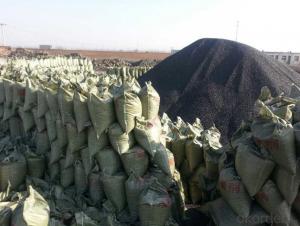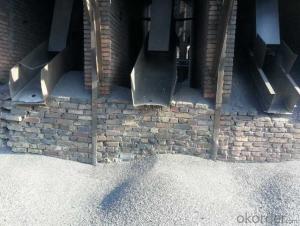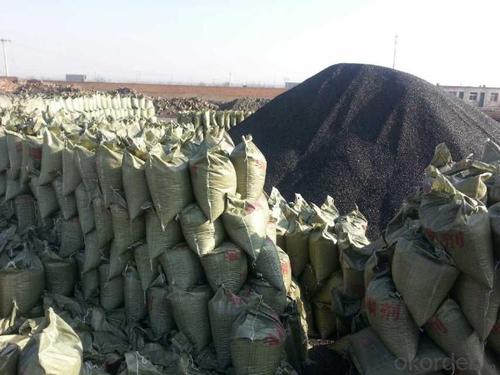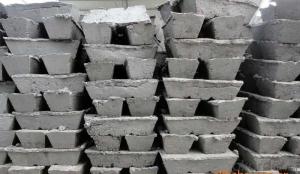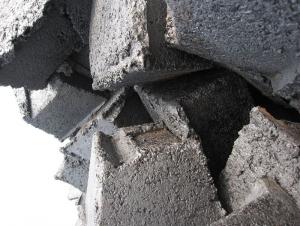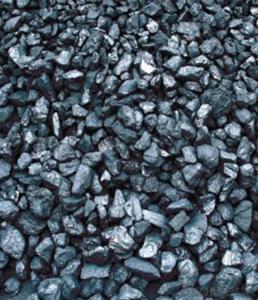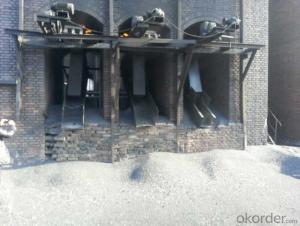Charge Coke FC82-90 Made From Taixi Anthracite
- Loading Port:
- Lianyungang
- Payment Terms:
- TT OR LC
- Min Order Qty:
- 20 m.t.
- Supply Capability:
- 3500 m.t./month
OKorder Service Pledge
OKorder Financial Service
You Might Also Like
Charge Coke FC82-90
Features
Calcined Anthracite
Fixed carbon: 90%-95%
S: 0.5% max
Size: 0-3. 3-5.3-15 or as request
It used the high quality anthracite as raw materials through high temperature calcined at over 2000 by the DC electric calciner with results in eliminating the moisture and volatile matter from anthracite efficiently, improving the density and the electric conductivity and strengthening the mechanical strength and anti-oxidation. It has good characteristics with low ash, low resistvity, low sulphur, high carbon and high density. It is the best material for high quality carbon products.
Packaging & Delivery
25kgs/50kgs/1ton per bag or as buyer's request
Advantage and competitive of caclined anthracite
1. strong supply capability
2. fast transportation
3. lower and reasonable price for your reference
4.low sulphur, low ash
5.fixed carbon:95% -90%
6..sulphur:lower than 0.3%
General Specification of Calcined Anthracite
| FC | 95 | 94 | 93 | 92 | 90 |
| ASH | 4 | 5 | 6 | 6.5 | 8.5 |
| V.M. | 1 | 1 | 1 | 1.5 | 1.5 |
| S | 0.3 | 0.3 | 0.3 | 0.35 | 0.35 |
| MOISTURE | 0.5 | 0.5 | 0.5 | 0.5 | 0.5 |
Pictures

- Q: What is the density of carbon steel and alloy steel?
- Chromium molybdenum aluminum steel 7.65Tungsten 9 high speed tool steel 8.3Tungsten 18 high speed tool steel 8.7High strength alloy steel 7.82Bearing steel 7.81Stainless steel 0Cr13, 1Cr13, 2Cr13, 3Cr13, 4Cr13, Cr17Ni2, Cr18, 9Cr18, Cr25,, Cr28 7.75Cr14, Cr17 7.70Cr18Ni9, 1Cr18Ni9, Cr18Ni9Ti, 2Cr18Ni9 7.851Cr18Ni11Si4A1Ti 7.52Stainless steel 1Crl8NillNb, Cr23Ni18 7.92Cr13Ni4Mn9 8.53Cr13Ni7Si2 8
- Q: What is the carbon content of different fuels?
- The carbon content of different fuels can vary significantly depending on their composition and source. However, in general, fossil fuels such as coal, oil, and natural gas have high carbon content. Coal, which is primarily composed of carbon, typically contains around 60-80% carbon. This makes coal a highly carbon-intensive fuel and a major contributor to greenhouse gas emissions when burned. Crude oil and petroleum products, such as gasoline and diesel, also have high carbon content, ranging from 80-90%. When these fuels are burned, they release significant amounts of carbon dioxide (CO2) into the atmosphere. Natural gas, consisting mainly of methane (CH4), has a lower carbon content compared to coal and oil. Methane itself is composed of one carbon atom and four hydrogen atoms, resulting in a carbon content of around 75%. Although natural gas emits less CO2 when burned compared to coal and oil, methane itself is a potent greenhouse gas, which can contribute to climate change. Renewable fuels, such as biofuels, have varying carbon contents depending on their source. Biofuels are derived from organic materials, such as plants and agricultural waste, and can have carbon contents similar to fossil fuels. However, since biofuels are derived from recently living organisms, the carbon dioxide emitted during their combustion is considered part of the natural carbon cycle and does not contribute to long-term increases in atmospheric CO2 levels. Overall, the carbon content of different fuels is an important factor in determining their environmental impact and contribution to climate change. Transitioning to low-carbon or carbon-neutral fuels is crucial in reducing greenhouse gas emissions and mitigating the effects of climate change.
- Q: Appearance, hardness, electrical conductivity, use of carbon 60
- For gas storageThe unique molecular structure of C60, C60 can be used as more effective and new hydrogen absorbing material than metal and alloy. There are 30 carbon carbon double bonds, each molecule of C60 so that the C60 molecules in the double bond open can absorb hydrogen. Stable C60 hydride has known C60 C60H24, C60H36 and C60H48. in the control of temperature and pressure conditions, can be simply made by C60 C60 and hydrogen hydrides, it at room temperature is very stable, and in the 80 to 215 DEG C, C60 hydride will release hydrogen, leaving the pure C60, it can be 100% recovery, and was used to prepare C60 hydride. Compared with the hydrogen storage materials of metal or its alloys, C60 hydrogen storage has the advantages of low price, and lighter than C60, metals and alloys, therefore, the same quality of material, the hydrogen storage of C60 metal or its alloy than more.C60 not only can store hydrogen, can also be used to store oxygen. Compared with high-pressure cylinders of oxygen storage, high pressure cylinder pressure is 3.9 * 106Pa, belongs to the high pressure oxygen storage method, and storage of C60 oxygen pressure is only 2.3 * 105 Pa, which belongs to low pressure oxygen storage method. Using C60 under low pressure, large storage has many uses of oxygen in the medical departments, military departments and the business sector will be.
- Q: Why is the longer the carbon chain, the better the hydrophobic properties?
- I only know that the carbon chain is hydrophobic, so the longer it stronger. But why hydrophobic carbon chain is hydrophobic, hydrocarbon is because of hydrophobic group, the hydrophobic alkyl and why? I don't know, can be very the problem of bai123 (inline station TA) the longer the pure carbon chain, the better the symmetry, the worse the polarity, showing a strong hydrophobic, lqn513 (in station contact TA) similar, compatible ah, polarity is different, compatibility is different, zhu2du1314 (station contact TA), this is obvious......
- Q: Is aluminum alloy expensive or high carbon steel expensive?
- Aluminum alloy of course, a little longer, and will be much lighter.Generally, aluminum alloy frames are much more expensive than those of high carbon steel.
- Q: How does carbon affect the quality of soil?
- Soil quality is greatly influenced by carbon, which plays a vital role in its determination. When dead plants and animals decompose, they release carbon into the soil, a process known as carbon sequestration. This process is crucial for maintaining the fertility and health of the soil. The presence of carbon in the soil is beneficial for the growth of microorganisms such as bacteria and fungi. These microorganisms contribute to the breakdown of organic matter and the recycling of nutrients. Their presence helps create a fertile soil environment, ensuring that plants can absorb essential nutrients. Moreover, carbon in the soil improves its structure and its ability to hold water. It acts like a sponge, allowing the soil to retain moisture, which is essential for the growth and survival of plants. Carbon also prevents soil erosion by binding particles together, reducing the risk of nutrient loss and water runoff. Additionally, carbon enhances the soil's capacity to store and release nutrients. It acts as a reservoir for elements like nitrogen, phosphorus, and potassium, gradually releasing them to plants over time. This nutrient cycling is vital for sustaining healthy plant growth and productivity. However, modern agricultural practices, including excessive tilling, overuse of synthetic fertilizers, and deforestation, have caused a significant decline in soil carbon levels. This loss of carbon negatively impacts soil quality, resulting in decreased fertility, increased erosion, and reduced water-holding capacity. To counteract these negative effects, it is essential to adopt sustainable agricultural practices that focus on carbon sequestration and soil conservation. These practices involve reducing tillage, incorporating cover crops, practicing crop rotation, and using organic fertilizers. By increasing carbon levels in the soil, we can improve its quality, promote plant growth, and ensure the long-term sustainability of our agricultural systems.
- Q: What are the impacts of carbon emissions on the stability of tundra ecosystems?
- The stability of tundra ecosystems is significantly and extensively affected by carbon emissions. Greenhouse gases like carbon dioxide and methane, which are emitted into the atmosphere, contribute to global warming and climate change. Consequently, tundra ecosystems, which are particularly susceptible to temperature fluctuations, suffer various adverse consequences. To begin with, increased carbon emissions result in higher temperatures, leading to the thawing of permafrost in the tundra. Permafrost, which is permanently frozen soil, serves as the foundation for the tundra ecosystem. Its thawing compromises the stability of the entire ecosystem, rendering the ground unstable and causing landscapes to collapse, landslides to occur, and drainage patterns to be altered. This disruption negatively affects the habitats of plants and animals, as well as the distribution of water resources. Moreover, as permafrost thaws, organic matter that has been frozen for thousands of years begins to decompose. This decomposition process releases substantial amounts of carbon dioxide and methane into the atmosphere, intensifying the greenhouse effect. This feedback loop accelerates climate change and contributes to the overall increase in carbon emissions. Furthermore, the thawing of permafrost also impacts the vegetation in tundra ecosystems. Many plant species in the tundra rely on the stability and availability of nutrients provided by the permafrost layer. With its degradation, plants encounter difficulties in establishing and maintaining their root systems. This subsequently reduces plant productivity and alters the composition of plant communities. Changes in vegetation can have consequences for wildlife, such as reindeer, caribou, and migratory birds, which depend on specific plant species for sustenance and shelter. Additionally, the increased thawing of permafrost releases previously trapped pollutants and contaminants, which further jeopardize the stability of tundra ecosystems. These pollutants, including heavy metals and toxic chemicals, can enter waterways and disrupt the delicate balance of the ecosystem, impacting aquatic life. In conclusion, carbon emissions contribute to the destabilization of tundra ecosystems through the thawing of permafrost, alteration of vegetation, release of greenhouse gases, and contamination of water resources. These impacts not only affect the unique biodiversity of the tundra but also have implications for global climate change. It is crucial to reduce carbon emissions and mitigate the effects of climate change to preserve the stability and integrity of these fragile ecosystems.
- Q: How do human activities contribute to carbon emissions?
- Human activities contribute to carbon emissions in several ways. The burning of fossil fuels for electricity, transportation, and industry is one of the main sources of carbon dioxide emissions. When we burn coal, oil, or natural gas, carbon is released into the atmosphere. Additionally, deforestation and land-use changes also contribute to carbon emissions. Trees play a crucial role in absorbing carbon dioxide, so when forests are cleared for agriculture or urbanization, the stored carbon is released back into the atmosphere. Moreover, industrial processes such as cement production and chemical manufacturing also release carbon emissions. Finally, human activities like agriculture and livestock farming can produce methane, a potent greenhouse gas that contributes to global warming. Overall, our reliance on fossil fuels, deforestation, industrial processes, and certain agricultural practices all contribute to carbon emissions, exacerbating the problem of climate change.
- Q: What is the burning point of carbon?
- There are many forms of carbon, such as charcoal, coal, and even diamonds!And different forms have different ignition points!
- Q: How is carbon dioxide formed?
- Carbon dioxide is formed through various natural and human activities. It is naturally produced by the respiration of animals, the decay of organic matter, and volcanic eruptions. Additionally, human activities such as the burning of fossil fuels, deforestation, and industrial processes also contribute to the formation of carbon dioxide.
Send your message to us
Charge Coke FC82-90 Made From Taixi Anthracite
- Loading Port:
- Lianyungang
- Payment Terms:
- TT OR LC
- Min Order Qty:
- 20 m.t.
- Supply Capability:
- 3500 m.t./month
OKorder Service Pledge
OKorder Financial Service
Similar products
Hot products
Hot Searches
